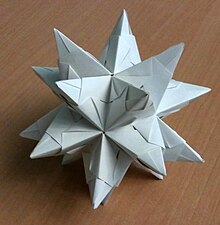Bascetta star
A Bascetta star is a certain shape of a poinsettia , which is constructed as a modular origami . The star is named after the Italian math professor Paolo Bascetta, who invented it. It is used in mathematics exhibitions to give school children clear access to polyhedra and three-dimensional symmetry. Bascetta also has other 2D and 3D origami stars, such as the Bascetta star 2.
shape
A Bascetta star is formed by an icosahedron , which is one of the five platonic solids . A three-sided pyramid rises above each of its 20 surfaces . The resulting geometric body is called an icosahedral star . Thus the star has 20 points. To build it, you need 30 equally sized, square sheets of paper . These are all folded identically and finally put together to form a star. No scissors or glue are required for this. The finished star is stable because the individual parts turn into one another like a screw. As a result, they jam each other. The individual part is therefore also called the " Tornillo module " (ital. For screw).
Variations
There are numerous variants of the star that are not limited to just different sizes. You can achieve impressive effects by using different colored sheets of paper or transparent paper. You can also use the finished origami z. B. dip in wax to make it even more stable.
The modular parts for the Bascetta buttons can be used to produce all stars based on the Platonic and Archimedean solids , not just icosahedral stars . The number of edges then corresponds to the number of parts to be folded and the number of sides to the number of tips of the finished star. In addition, many other variants of the star are possible by plugging the parts together differently.
confusion
Bascetta stars are also often referred to as Aurelio stars. An “Aurelio star” is a similar star, also based on an icosahedron and with equilateral triangular individual parts, the individual parts of which are glued together. The rights for the Aurelio star are held by Frechverlag. Publication on the Internet is theoretically not permitted. The star of the supposed experts u. a., in which the 30 leaves form steeper tips and smooth surfaces because of a different folding technique, is a "Super Simple Isosceles Triangle Unit Copyright © 2002 by M. Mukhopadhyay", SSIT-Unit for short.
literature
- Paolo Bascetta, Y. Roger Weber: Bascetta's ORIGAMI STAR: 3D star made of paper. Nice Papers Q-Verlag, 2007, ISBN 978-3-938127-07-0 .
- Ingrid Moras: Beautiful Bascetta stars. Christophorus-Verlag, 2011, ISBN 978-3-8388-3239-5 .
- Nicole Weicker, Karsten Weicker: Coloring the Origamister . In: Volker Diekert, Kasten Weicker, Nicole Weiker (ed.): Computer science as a dialogue between theory and application: Festschrift for Volker Claus on his 65th birthday . Vieweg + Teubner, Wiesbaden 2009, ISBN 978-3-8348-0824-0 , chap. 19 , p. 227-238 , doi : 10.1007 / 978-3-8348-9982-8_19 .
Web links
- Bascetta-Stern mathematische-basteleien.de
- Video instructions for crafting the star on Youtube
- Folding instructions on Origamipage.de as PDF
Individual evidence
- ^ Biografia di Paolo Bascetta
- ↑ Bianca Violet, Milena Damrau: Science Spaces: An Open Workshop Concept to Create Science Exhibits. Imaginary , July 2018, accessed December 1, 2018 (Short paper, Bridges 2018 , Stockholm).
- ↑ Stella 1 , accessed April 12, 2019
- ↑ Roulette , accessed April 12, 2019
- ↑ Veneziana , accessed April 12, 2019
- ^ Hollow Sonobe , accessed April 12, 2019
- ↑ Bascetta-Stern 2 , accessed April 12, 2019
- ↑ Christa Hofer: The mathematics of the poinsettia: The icosahedron, one of the five Platonic solids, is the basis for a special form of the poinsettia: the Bascetta star, which was invented by an Italian mathematician. In: Worth knowing: Magazin der Leopold-Franzens-Universität Innsbruck, December 10, 2013, p. 4, accessed on December 12, 2013.
- ↑ Christa Hofer: The mathematics of the poinsettia: The icosahedron, one of the five Platonic solids, is the basis for a special form of the poinsettia: the Bascetta star, which was invented by an Italian mathematician. In: Worth knowing: Magazine of the Leopold Franzens University Innsbruck, December 10, 2013, pp. 4–5. Retrieved December 12, 2013.
- ^ Tornillo module , accessed February 12, 2019
- ↑ Armin Täubner: Aurelio-Stern: Fascinating folded stars made of paper. Frechverlag, 2008, ISBN 978-3-7724-3708-3
- ↑ SSIT-Unit [1] , accessed on February 12, 2019.
